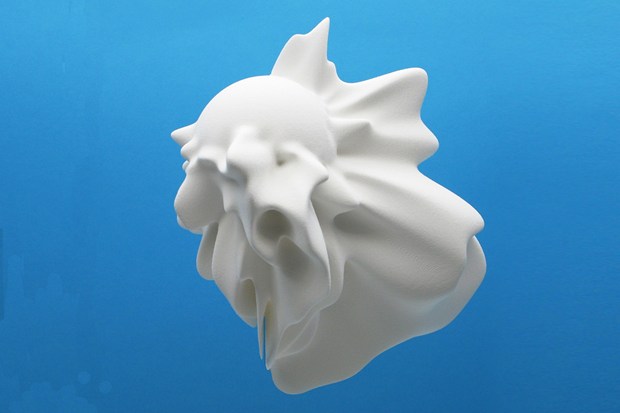Rapid Ready Roundup: Stars, 3D Systems, British AM Centers and The Hobbit

3D printed depiction of radiation from a pulsar. Courtesy of Katie Davies and Peter Walters.
Latest News
July 24, 2012
In the course of my diligent efforts to keep you good people up to date on the state of additive manufacturing, I come across many interesting news items. I’ll gather them up every so often and present them in a Rapid Ready Roundup (like this one). You can find the last Roundup here.
Just when I think I’ve seen nearly every possible use for additive manufacturing (AM), someone else figures out a new way to surprise me. Katie Davies and Peter Walters used a 3D printer to create Vela, an artistic interpretation of the radiation beam of a pulsar star. Data for the project came from information recorded in 1970 by the US National Radio Astronomy Observatory in Charlottesville, VA.
“We created the 3D plot based on a digital audio file corresponding to the radiation beam from the pulsar received by a radio telescope,” said Walters. “This was used to generate the shape of the sculptural artwork, which was fabricated by 3D printing.”
Vela is now on display as part of the Mixed Signals exhibition at Boston Cyber Arts.
Moving back to Earth, 3D Systems has announced the acquisition of Viztu Technologies. Viztu specializes in, “custom multi-dimensional scanning and content creation solutions.” 3D Systems will incorporate Vitzu into its Cubify site to assist users in creating their own 3D content.
“Viztu adds an important building block to our growing Cubify platform. Now everyone can begin to express themselves in 3D as easily as snapping a picture,” said Cathy Lewis, vice president global marketing for 3D Systems. “We believe that this investment will accelerate the democratization of the entire 3D create and make experience for everyone.”
Moving overseas (from me, at least), Irish entrepreneur Elgin Loane is ready to invest serious cash into a series of AM production centers. Loane plans to build eight centers in London over the next 18 months, with possible future expansion into Birmingham or Manchester. Total cost for the project is around £500,000 ($775,600).
“I want to raise awareness of what 3D printing can offer,” said Loane. “London is an ideal place to begin a venture of this sort because of the concentration in the city of small businesses, many of which are involved in creating new products in small volumes.”
Finally, 3D printing has been used to great effect in a number of movies. Weta Workshop has leveraged the technology as part of its efforts to create weapons and costumes for the Lord of the Rings and upcoming Hobbit movies.
“We use 3D printing extensively. It allows us to take digital models and turn them into three dimensional physical objects,” said Richard Taylor of Weta Workshop.
Weta Workshop’s animatronics engineers are also following the development of large-scale AM systems, with the idea of using them to create life-sized props. As is the case with other industries, use of AM allows Weta Workshop’s to speed up time-to-market (or time-to-screen, in this case) by speeding concept design and creation of custom theatrical equipment.
Below you’ll find a short video featuring Weta Workshop.
Sources: Wired, Financial Times, 3D Systems, TVNZ
Subscribe to our FREE magazine, FREE email newsletters or both!
Latest News
About the Author
John NewmanJohn Newman is a Digital Engineering contributor who focuses on 3D printing. Contact him via [email protected] and read his posts on Rapid Ready Technology.
Follow DE






